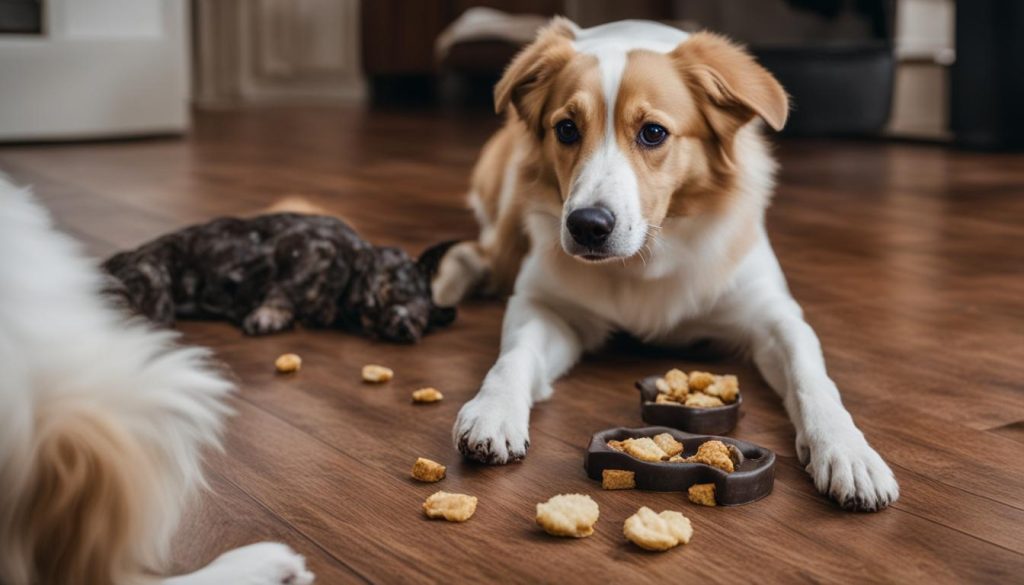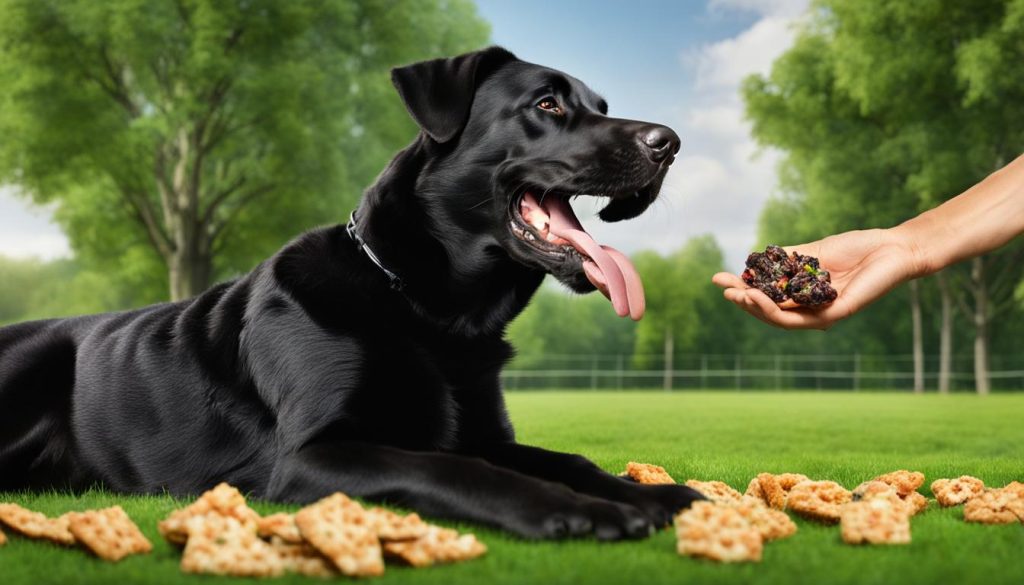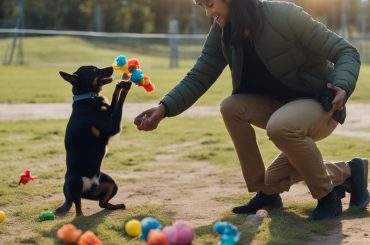When it comes to dog training, teaching your furry friend fun and impressive tricks can be both entertaining and rewarding. One trick that never fails to impress is “playing dead.” Not only does this trick showcase your dog’s intelligence and obedience, but it also strengthens the bond between you and your canine companion.
Whether you’re a beginner or an experienced trainer, this article will guide you through the process of teaching your dog to play dead. From basic obedience commands to using positive reinforcement techniques, you’ll learn everything you need to know to successfully train your dog in this captivating trick.
Key Takeaways:
- Playing dead is a fun trick that can be taught using positive reinforcement techniques.
- Start by ensuring your dog knows the “lie down” command and can comfortably roll onto its side.
- Use tasty treats and clicker training to reward your dog’s progress and establish a cue word and hand signal.
- Be patient and consistent in your training sessions, gradually increasing the duration of the “dead” position.
- Teaching tricks not only entertains but also strengthens the bond between you and your dog.
The Benefits of Teaching Your Dog Fun Tricks
Teaching your dog fun tricks, such as playing dead, offers a range of benefits for both you and your furry friend. These tricks can be a wonderful way to strengthen the bond between you and your dog while providing mental and physical stimulation. Additionally, incorporating fun tricks into your dog’s training routine can be a refreshing alternative to traditional obedience training methods.
One of the key advantages of teaching your dog fun tricks is that it promotes positive behavior through positive reinforcement. Using reward-based training techniques, like clicker training, allows you to effectively communicate with your dog and motivate them to learn new skills. This method focuses on rewarding desired behaviors, creating a positive association with the trick, and encouraging your dog to repeat it.
Moreover, teaching your dog fun tricks can enhance their overall obedience and listening skills. By engaging with your dog in a playful manner, you build their confidence and strengthen their ability to follow commands. These tricks also provide mental stimulation, which can help alleviate boredom and prevent destructive behaviors that may occur when dogs are understimulated.
| Benefits of Teaching Fun Tricks | |
|---|---|
| Strengthens the bond between you and your dog | Builds trust and enhances communication |
| Provides mental and physical stimulation | Prevents boredom and destructive behaviors |
| Promotes positive behavior through positive reinforcement | Encourages obedience and listening skills |
Teaching your dog fun tricks can be a delightful experience that brings joy and laughter to your household. It allows you to bond with your furry companion while imparting valuable skills and fostering a positive training environment. Remember, patience and consistency are essential when teaching any new trick to your dog.
In summary, teaching your dog fun tricks, such as playing dead, offers numerous benefits. It strengthens the bond between you and your dog, provides mental and physical stimulation, promotes positive behavior through positive reinforcement, and enhances overall obedience. So get started today and unleash the potential of your dog’s playful abilities!
Getting Started with Clicker Training
Clicker training is a popular method for teaching dogs new tricks. It is a positive reinforcement technique that uses a clicker to mark desired behaviors, followed by a reward. To get started with clicker training, you’ll need a clicker and plenty of tasty treats.
The first step is to associate the sound of the clicker with a reward. Click the clicker and immediately give your dog a treat. Repeat this process several times until your dog understands that the clicker sound means a reward is coming.
Once your dog is familiar with the clicker, you can use it to mark desired behaviors. For example, if you want to teach your dog to play dead, wait for it to lie down, click the clicker, and then reward your dog with a treat. Repeat this process until your dog associates the click with the desired behavior.
To teach your dog the command for playing dead, you can pair the clicker with a verbal command, such as “play dead.” Say the command, wait for your dog to perform the behavior, click the clicker, and reward your dog with a treat. Consistently using the clicker and the verbal command will help your dog recognize and respond to the cue for the trick.
| Steps to Getting Started with Clicker Training | Benefits |
|---|---|
| 1. Associate the clicker sound with a reward | – Reinforces desired behaviors |
| 2. Use the clicker to mark desired behaviors | – Clear communication with your dog |
| 3. Pair the clicker with a verbal command | – Helps your dog recognize the cue for the trick |
Clicker training can be a highly effective and efficient method for teaching your dog new tricks. It allows for clear communication and helps your dog understand which behaviors are desired. Remember to be patient and consistent in your training sessions, and always reward your dog for its efforts.
If you need to purchase a clicker for clicker training, you can find them at most pet stores or online retailers that specialize in dog training supplies.
Step-By-Step Guide to Teaching Your Dog to Play Dead

In this section, I will provide you with a detailed step-by-step guide to teach your dog the “play dead” trick. Remember to be patient and consistent throughout the training process, and always use positive reinforcement techniques to motivate your furry friend.
Step 1: Command your dog to lie down
To begin teaching your dog to play dead, start by giving the “lie down” command. Use a treat as a lure to encourage your dog to lie down on its belly. Reward your dog with verbal praise and a treat when it successfully follows the command.
Step 2: Introduce the rolling motion
Once your dog is comfortable with the “lie down” command, hold a treat close to its nose and slowly move it to the side. This will encourage your dog to roll onto its side. When your dog successfully lies on its side, reward it with a click or verbal praise and a treat.
Step 3: Add a cue word and hand signal
As your dog becomes more familiar with the rolling motion, start adding a cue word and hand signal to associate with the “play dead” trick. Choose a simple word like “dead” and a hand signal such as pointing your finger to the ground. Use these cues consistently during training to help your dog understand what is expected of it.
Step 4: Increase the duration
Gradually increase the length of time your dog stays in the “dead” position before rewarding it. Start with just a few seconds and slowly work your way up to longer durations. Be sure to reward your dog each time it successfully stays in the position. Practice regularly and be patient with your dog’s progress.
By following this step-by-step guide, you can successfully teach your dog to play dead. Remember to keep training sessions fun and positive for both you and your furry friend. With patience and consistency, your dog will master this entertaining trick in no time!
Teaching the Play Dead Trick to Puppies

Teaching your puppy fun tricks, like playing dead, can be an exciting and rewarding experience for both of you. Puppies are generally quick learners and eager to please, making them great candidates for trick training. To teach your puppy the play dead trick, it’s important to start with a solid foundation of basic commands, such as “down” and “stay.”
Begin by practicing the “down” command with your puppy using positive reinforcement techniques. Once your puppy is comfortable with lying down on command, you can start introducing the play dead trick. Use a treat to lure your puppy onto its side while saying a cue word like “dead” or “sleep.” Click or use a marker word to mark the correct behavior and reward your puppy with a treat. Repeat this process, gradually adding verbal cues and hand signals to accompany the trick.
Consistency is key when training your puppy. Practice the play dead trick regularly in short training sessions to keep your puppy engaged and motivated. Be patient and remember that each puppy learns at their own pace. If your puppy becomes frustrated or tired during training, take a break and try again later. With time and practice, your puppy will master the play dead trick and impress everyone with their new skill!
| Steps to Teach the Play Dead Trick to Puppies | Benefits |
|---|---|
| 1. Start with basic commands 2. Introduce the play dead trick 3. Use positive reinforcement and rewards 4. Practice regularly and be patient 5. Celebrate your puppy’s progress |
|
Tips for Successful Puppy Trick Training
- Keep training sessions short and fun to maintain your puppy’s interest.
- Use high-value treats that your puppy finds irresistible.
- Provide plenty of positive reinforcement and verbal praise during training.
- Be consistent with your cues and hand signals to help your puppy understand what is expected.
- Avoid punishment or negative reinforcement, as it can inhibit your puppy’s learning and enthusiasm.
Remember, puppies have short attention spans, so it’s important to keep training sessions engaging and positive. With patience, consistency, and lots of love, you’ll have your puppy performing impressive tricks in no time!
Troubleshooting Tips for Teaching the Play Dead Trick

Teaching your dog to play dead can be a fun and rewarding experience, but sometimes dogs can encounter difficulties during the training process. If your dog is struggling to learn the play dead trick, there are some troubleshooting tips you can try to help them succeed.
Use a Non-Slip Surface
During training sessions, it’s important to provide your dog with a comfortable surface to lie on. Using a non-slip surface, such as a yoga mat or carpet, can help your dog feel more secure and prevent them from sliding or losing their balance while attempting the trick.
Pay Attention to Body Language
Understanding your dog’s body language is crucial when teaching them new tricks. If you notice that your dog is becoming frustrated or anxious during the training session, adjust your approach accordingly. Take breaks, offer encouragement, and modify the training steps if necessary.
Try Luring in the Opposite Direction
If your dog seems hesitant or reluctant to roll onto a specific side, try luring them in the opposite direction. Sometimes dogs can have a preference for one side over the other, but by gradually guiding them towards the desired position, they can learn to perform the trick on both sides.
Create a Calm Training Environment
Dogs can easily become distracted, especially when learning new tricks. To ensure successful training sessions, create a calm and quiet environment free from distractions. This will help your dog focus on the task at hand and improve their learning experience.
Consult with a Professional Trainer
If you’ve tried various troubleshooting tips and your dog is still struggling to learn the play dead trick, it may be beneficial to seek guidance from a professional dog trainer. They can provide personalized advice and training techniques to address any specific challenges your dog may be facing.
Remember, patience and consistency are key when training your dog. Keep the training sessions positive and enjoyable for your dog, and celebrate their progress along the way. With time and practice, your dog will master the play dead trick and impress everyone with their newfound skill!
Expanding Your Dog’s Trick Repertoire

Now that your dog has mastered the play dead trick, it’s time to expand its trick repertoire! Teaching your dog new tricks can be a fun way to challenge its mental and physical abilities, while also strengthening your bond. Here are some ideas to get you started:
1. Rolling Over
Teaching your dog to roll over is another popular trick that can impress your friends and family. Start by commanding your dog to lie down, then hold a treat close to its nose and slowly move it in a circular motion. As your dog follows the treat with its nose, it will naturally roll over onto its back. Reward your dog with a click or verbal praise and a treat when it successfully rolls over. Repeat this process, adding a cue word like “roll over” and a hand signal, until your dog can perform the trick on command.
2. High Five
Teaching your dog to give you a high five is a fun and interactive trick that can be a hit at parties or social gatherings. Start by commanding your dog to sit, then hold a treat in your hand just above its paw. Encourage your dog to paw at your hand by gently tapping its paw with the treat. When your dog raises its paw to touch your hand, reward it with a click or verbal praise and a treat. Repeat this process, adding a cue word like “high five” and a hand signal, until your dog can confidently give you a high five.
3. Speak
Teaching your dog to speak on command can be a fun way to show off its vocal abilities. Start by waiting for your dog to bark naturally, then immediately reward it with a click or verbal praise and a treat. Pair this reward with a cue word like “speak” and a hand signal, such as raising your hand to your mouth like you’re talking. Repeat this process, gradually phasing out the natural bark and only rewarding your dog when it barks on command. With practice, your dog will learn to speak when you give the cue.
Remember, when teaching your dog new tricks, patience and consistency are key. Keep training sessions fun and positive, and always reward your dog for its efforts. With time and practice, your dog will become a trick master!
The Importance of Patience and Consistency in Dog Training

When it comes to dog training, patience and consistency are crucial for success. It’s important to remember that each dog learns at its own pace, so it’s essential to be patient and understanding throughout the training process. Whether you’re teaching your dog basic obedience commands or fun tricks like playing dead, maintaining a patient and consistent approach will yield the best results.
Consistency is key in dog training. Dogs thrive on routine and repetition, so it’s important to use the same cues and commands consistently. This helps your dog understand what is expected of it and reinforces the desired behaviors. Consistency also extends to your training sessions. Try to establish a regular training schedule and stick to it, as this will provide structure and stability for your dog.
In addition to consistency, patience is equally important. Dogs may not grasp a new command or trick immediately, and it’s essential to give them time to learn and understand. Rushing the process can lead to frustration for both you and your dog. Instead, take a step back, break the training into smaller steps, and reward your dog for each small achievement along the way. Celebrate your dog’s progress and be patient, knowing that with time and practice, they will master the desired behavior.
Remember that training should be a positive and enjoyable experience for both you and your dog. Keep the sessions fun, engaging, and rewarding. Use treats and praise to motivate your dog and make the training sessions something they look forward to. By being patient and consistent, you can build a strong bond with your dog and achieve your training goals together.
Wrapping Up
To conclude, teaching your dog to play dead can be a rewarding and enjoyable experience for both you and your furry friend. By incorporating positive reinforcement techniques, such as clicker training, and maintaining patience and consistency in your training sessions, you can successfully teach your dog this fun trick.
Remember that dog training requires time and dedication, so be sure to approach it with a positive mindset and a willingness to celebrate your dog’s progress along the way. It’s important to keep the training sessions fun and engaging for your dog, as this will help maintain their interest and motivation.
Additionally, don’t limit yourself to just one trick! Once your dog has mastered the play dead trick, you can continue to expand their trick repertoire and challenge their mental and physical abilities. Consider teaching tricks like rolling over or high five, always using positive reinforcement techniques to encourage their success.
In summary, with the right approach and a little patience, you can achieve great results in teaching your dog tricks. Remember to have fun, stay consistent, and enjoy the bonding experience that comes with training your four-legged companion.
FAQ
Can I teach my dog to play dead even if it doesn’t know any other commands?
It’s best to start with the “lie down” command before teaching your dog to play dead. Once your dog understands how to lie down, you can begin training it to roll onto its side.
What kind of treats should I use for clicker training?
Use tasty treats that your dog loves. Small, soft treats that can be easily consumed are usually the most effective.
How long does it take to teach a dog to play dead?
The time it takes to teach a dog a new trick can vary depending on the dog’s individual learning pace. Be patient and consistent in your training sessions, and your dog will eventually learn the trick.
Can older dogs learn to play dead?
Yes, older dogs can learn new tricks! It may take them a bit longer to pick up the trick compared to puppies, but with patience and consistent training, they can learn to play dead.
My dog is scared of the clicker. What should I do?
If your dog is scared of the clicker, try using a verbal marker word instead. Choose a word like “yes” or “good” and use it consistently to mark desired behaviors.
What should I do if my dog gets distracted during training?
Make sure you’re training in a calm and quiet environment, free from distractions. If your dog gets distracted, try to regain its attention by using higher value treats or using a more engaging training technique.
My dog keeps rolling onto its back instead of lying on its side. What should I do?
If your dog is consistently rolling onto its back instead of lying on its side, try luring it in the opposite direction. If it still doesn’t work, consult with a professional trainer for further guidance.
Can I teach my dog multiple tricks at the same time?
Yes, you can teach your dog multiple tricks at the same time. However, it’s important to focus on one trick at a time during each training session to avoid confusion.
How often should I train my dog?
Regular training sessions, ideally a few minutes each day, are recommended to reinforce the behaviors and tricks you’re teaching your dog. Consistency is key to successful training.






